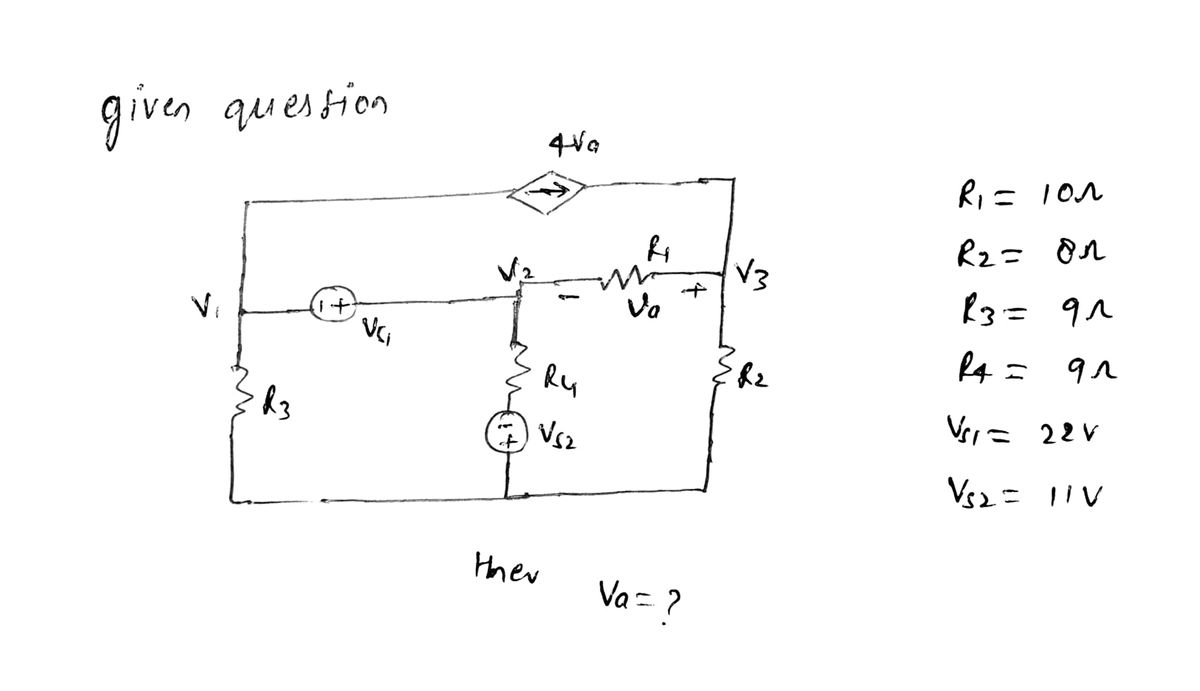R4-92, Vs1-22V, VS2=11V, 40. wwww R3 1 + Usl R₁ 4 Vs2 R₁ www Va + wwwww R₂ se nodal analysis to calculate the node voltages. Give the voltage va in
R4-92, Vs1-22V, VS2=11V, 40. wwww R3 1 + Usl R₁ 4 Vs2 R₁ www Va + wwwww R₂ se nodal analysis to calculate the node voltages. Give the voltage va in
Introductory Circuit Analysis (13th Edition)
13th Edition
ISBN:9780133923605
Author:Robert L. Boylestad
Publisher:Robert L. Boylestad
Chapter1: Introduction
Section: Chapter Questions
Problem 1P: Visit your local library (at school or home) and describe the extent to which it provides literature...
Related questions
Question
For the circuit below with the given reference node and R1=10 Ω , R2=8 Ω , R3=9 Ω , R4=9 Ω , vs1=22V, vs2=11V, Use nodal analysis to calculate the node voltages. Give the voltage va in Volts.

Transcribed Image Text:**Title: Nodal Analysis of a Electrical Circuit**
**Introduction:**
This section provides an analysis of an electrical circuit using nodal analysis, a systematic method for determining the voltage at each node in a circuit. Below is the description and schematic representation of the given circuit.
**Circuit Description:**
- **Resistors:**
- \( R_1 = 10 \Omega \)
- \( R_2 = 8 \Omega \)
- \( R_3 = 9 \Omega \)
- \( R_4 = 9 \Omega \)
- **Voltage Sources:**
- \( v_{s1} = 22V \)
- \( v_{s2} = 11V \)
**Schematic Diagram:**
- The schematic features a circuit with two voltage sources and four resistors.
- \( v_{s1} \) is connected in series with resistor \( R_3 \).
- \( v_{s2} \) is connected parallel to resistors \( R_4 \) and \( R_2 \), with the negative terminal grounded.
- A controlled voltage source, \( 4v_a \), depends on the voltage across \( R_1 \).
- \( R_4 \) and \( R_1 \) are in series, and their junction is the node of interest where \( v_a \) is measured.
- The circuit features a diamond-shaped dependent source \( 4v_a \) in the branch with the described resistors and voltage sources.
**Analysis Task:**
- Use nodal analysis to determine the voltage \( v_a \) at the given node.
- Calculate all node voltages by applying Kirchhoff's current laws (KCL) and the relationships defined by Ohm's law.
**Instructions:**
1. **Define Nodes:**
- Analyze the circuit by identifying all nodes. Choose the reference node (ground) and set it at 0V.
2. **Apply KCL:**
- At each non-reference node, apply Kirchhoff’s Current Law (KCL) to set up equations based on current entering and leaving a node.
3. **Solving Equations:**
- Use the relationships \( V = IR \) and solve the nodal equations to find \( v_a \).
This analysis will provide insight into voltage distribution across circuit components based on the configuration and component values.
Expert Solution
Step 1

Step by step
Solved in 2 steps with 2 images

Knowledge Booster
Learn more about
Need a deep-dive on the concept behind this application? Look no further. Learn more about this topic, electrical-engineering and related others by exploring similar questions and additional content below.Recommended textbooks for you

Introductory Circuit Analysis (13th Edition)
Electrical Engineering
ISBN:
9780133923605
Author:
Robert L. Boylestad
Publisher:
PEARSON

Delmar's Standard Textbook Of Electricity
Electrical Engineering
ISBN:
9781337900348
Author:
Stephen L. Herman
Publisher:
Cengage Learning

Programmable Logic Controllers
Electrical Engineering
ISBN:
9780073373843
Author:
Frank D. Petruzella
Publisher:
McGraw-Hill Education

Introductory Circuit Analysis (13th Edition)
Electrical Engineering
ISBN:
9780133923605
Author:
Robert L. Boylestad
Publisher:
PEARSON

Delmar's Standard Textbook Of Electricity
Electrical Engineering
ISBN:
9781337900348
Author:
Stephen L. Herman
Publisher:
Cengage Learning

Programmable Logic Controllers
Electrical Engineering
ISBN:
9780073373843
Author:
Frank D. Petruzella
Publisher:
McGraw-Hill Education

Fundamentals of Electric Circuits
Electrical Engineering
ISBN:
9780078028229
Author:
Charles K Alexander, Matthew Sadiku
Publisher:
McGraw-Hill Education

Electric Circuits. (11th Edition)
Electrical Engineering
ISBN:
9780134746968
Author:
James W. Nilsson, Susan Riedel
Publisher:
PEARSON

Engineering Electromagnetics
Electrical Engineering
ISBN:
9780078028151
Author:
Hayt, William H. (william Hart), Jr, BUCK, John A.
Publisher:
Mcgraw-hill Education,